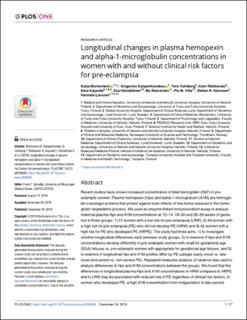| dc.contributor.author | Murtoniemi, Katja | |
| dc.contributor.author | Kalapotharakos, Grigorios | |
| dc.contributor.author | Vahlberg, Tero | |
| dc.contributor.author | Raikkonen, Katri | |
| dc.contributor.author | Kajantie, Eero Olavi | |
| dc.contributor.author | Hämäläinen, Esa | |
| dc.contributor.author | Åkerstrom, Bo | |
| dc.contributor.author | Villa, Pia M. | |
| dc.contributor.author | Hansson, Stefan R. | |
| dc.contributor.author | Laivuori, Hannele | |
| dc.date.accessioned | 2022-05-02T10:45:28Z | |
| dc.date.available | 2022-05-02T10:45:28Z | |
| dc.date.created | 2020-02-02T19:54:42Z | |
| dc.date.issued | 2019 | |
| dc.identifier.citation | PLOS ONE. 2019, 14 (12), 1-17. | en_US |
| dc.identifier.issn | 1932-6203 | |
| dc.identifier.uri | https://hdl.handle.net/11250/2993610 | |
| dc.description.abstract | Recent studies have shown increased concentration of fetal hemoglobin (HbF) in pre-eclamptic women. Plasma hemopexin (Hpx) and alpha-1-microglobulin (A1M) are hemoglobin scavenger proteins that protect against toxic effects of free heme released in the hemoglobin degradation process. We used an enzyme-linked immunosorbent assay to analyze maternal plasma Hpx and A1M concentrations at 12–14, 18–20 and 26–28 weeks of gestation in three groups: 1) 51 women with a low risk for pre-eclampsia (LRW), 2) 49 women with a high risk for pre-eclampsia (PE) who did not develop PE (HRW) and 3) 42 women with a high risk for PE who developed PE (HRPE). The study had three aims: 1) to investigate whether longitudinal differences exist between study groups, 2) to examine if Hpx and A1M concentrations develop differently in pre-eclamptic women with small for gestational age (SGA) fetuses vs. pre-eclamptic women with appropriate for gestational age fetuses, and 3) to examine if longitudinal Hpx and A1M profiles differ by PE subtype (early-onset vs. late-onset and severe vs. non-severe PE). Repeated measures analysis of variance was used to analyze differences in Hpx and A1M concentrations between the groups. We found that the differences in longitudinal plasma Hpx and A1M concentrations in HRW compared to HRPE and to LRW may be associated with reduced risk of PE regardless of clinical risk factors. In women who developed PE, a high A1M concentration from midgestation to late second trimester was associated with SGA. There were no differences in longitudinal Hpx and A1M concentrations from first to late second trimester in high-risk women who developed early-onset or. late-onset PE or in women who developed severe or. non-severe PE. | en_US |
| dc.language.iso | eng | en_US |
| dc.publisher | Public Library of Science | en_US |
| dc.rights | Navngivelse 4.0 Internasjonal | * |
| dc.rights.uri | http://creativecommons.org/licenses/by/4.0/deed.no | * |
| dc.title | Longitudinal changes in plasma hemopexin and alpha-1-microglobulin concentrations in women with and without clinical risk factors for pre-eclampsia | en_US |
| dc.title.alternative | Longitudinal changes in plasma hemopexin and alpha-1-microglobulin concentrations in women with and without clinical risk factors for pre-eclampsia | en_US |
| dc.type | Peer reviewed | en_US |
| dc.type | Journal article | en_US |
| dc.description.version | publishedVersion | en_US |
| dc.source.pagenumber | 1-17 | en_US |
| dc.source.volume | 14 | en_US |
| dc.source.journal | PLOS ONE | en_US |
| dc.source.issue | 12 | en_US |
| dc.identifier.doi | 10.1371/journal.pone.0226520 | |
| dc.identifier.cristin | 1789935 | |
| cristin.ispublished | true | |
| cristin.fulltext | original | |
| cristin.qualitycode | 1 | |

